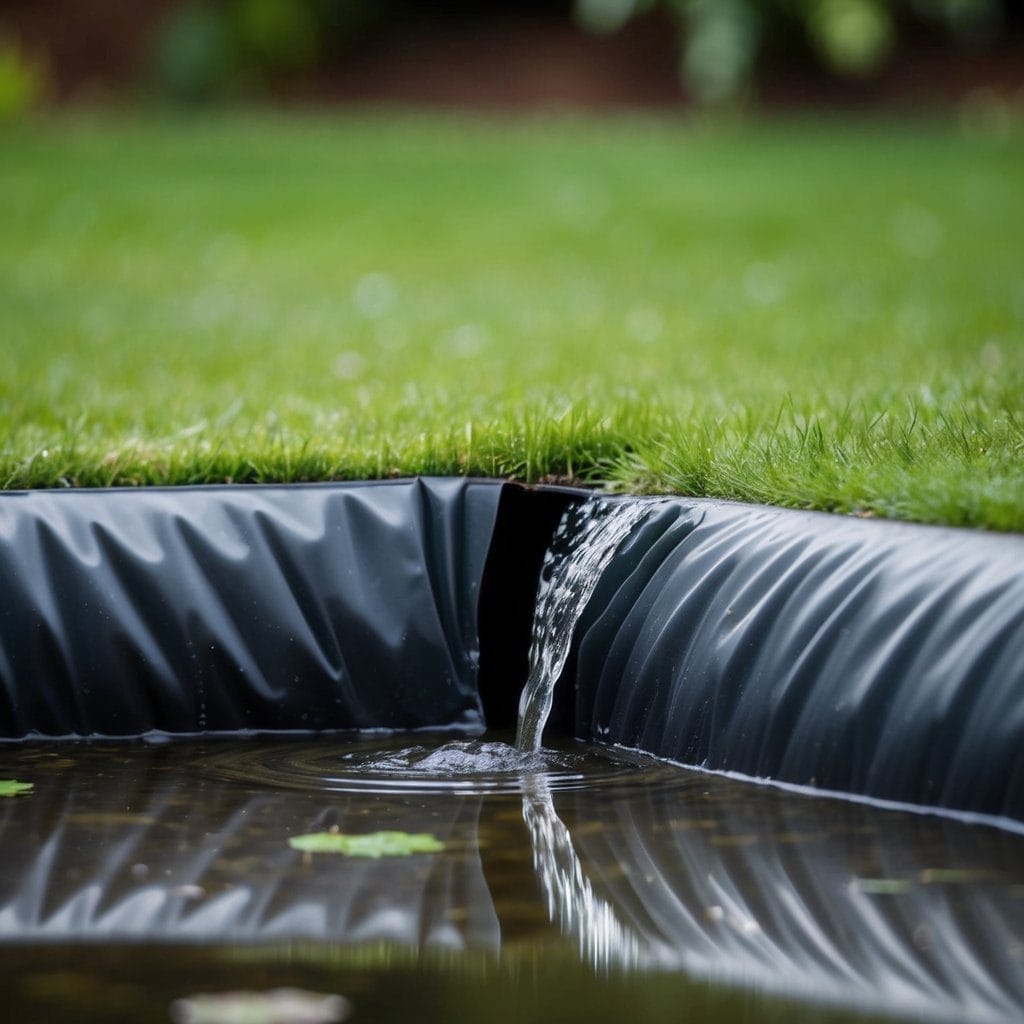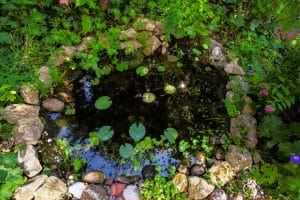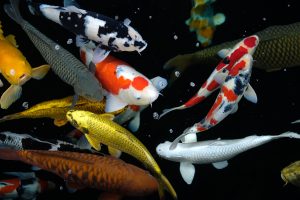
Why shouldn't I put a new pond liner over an old pond liner? Risks and proper replacement methods
Pond liners are crucial for keeping water in your garden pond.
When an old liner starts to fail, you might wonder if you can simply lay a new one over it.
While it may seem like an easy fix, this approach often leads to problems.

Putting a new pond liner over an old one can cause water to get trapped between the layers, leading to leaks and damage.
This trapped water can also create a breeding ground for harmful bacteria.
Plus, any sharp objects or roots that punctured the old liner may damage the new one too.
It’s better to remove the old liner and start fresh.
This allows you to check the pond base, fix any issues, and ensure a proper fit for the new liner.
While it takes more work up front, it saves time and money in the long run by avoiding future problems.
Key Takeaways
- Overlapping pond liners can trap water and cause leaks
- Removing the old liner allows for proper inspection and preparation
- Starting fresh with a new liner helps avoid future issues
Essentials of Pond Liner Replacement
Replacing a pond liner requires careful planning and proper technique. A successful replacement ensures a watertight pond that will last for years to come.
Assessing the Existing Pond Liner
Before installing a new liner, it’s crucial to examine the old one.
Look for punctures, tears, or cracks in the material. Check the seams and folds for weak spots.
Identify the cause of any damage. Stones or roots might have pierced the liner from below. This information helps prevent future issues.
If the old liner is EPDM or rubber, it may have lasted 20-30 years. PVC liners typically have a shorter lifespan. RPE liners are newer but also durable.
Remove any debris or sharp objects from the pond base. This step protects the new liner from damage.
Understanding Liner Lifespan
Different materials offer varying durability. EPDM and rubber liners often last the longest, up to 30 years or more. PVC liners may need replacement after 10-15 years.
Factors affecting lifespan include:
- Sun exposure
- Water chemistry
- Maintenance practices
- Quality of installation
Regular checks can extend a liner’s life. Look for signs of wear twice a year. Small repairs can prevent the need for full replacement.
Choose a high-quality liner for longevity. Thicker liners resist punctures better. UV-resistant materials cope well with sunlight exposure.
Potential Issues With Overlapping Liners

Placing a new pond liner over an old one can lead to serious problems. Two key issues are water leakage and lack of proper support for the pond structure.
Risk of Water Leakage
Overlapping pond liners can create hidden pathways for water to escape.
Old liners may have holes or cuts that aren’t visible but allow water to seep between the layers. This trapped water can cause further damage.
Even small gaps between the liners can let water through. Over time, this can lead to significant water loss from your pond. The space between liners may also harbour algae or bacteria.
To prevent leaks, it’s crucial to remove the old liner completely.
This allows for proper inspection of the pond base and installation of a new waterproof underlay.
Compromised Structural Support
Laying a new liner over an old one can affect the pond’s shape and stability.
The old liner may have wrinkles or folds that create uneven surfaces. This can lead to weak spots in the new liner.
The extra layer can also change the pond’s depth and edges. This might alter water levels and affect plants or fish habitats.
Proper structural support is vital for a healthy pond ecosystem.
Removing the old liner allows for reshaping and reinforcing the pond base.
This ensures better support for the new liner and helps maintain the pond’s intended design.
Importance of Proper Excavation and Preparation
Proper excavation and preparation are vital for a successful pond installation. These steps ensure a stable foundation and protect the new liner from damage.
Initial Excavation Considerations
When starting a pond project, careful excavation is key. The shape and depth of your pond depend on proper digging.
Use the right tools for the job, like a spade or mini-excavator for larger ponds.
Remove all rocks, roots, and debris from the area. These items can puncture your liner if left in place.
Smooth out any rough spots in the soil to create an even surface.
Make sure the edges of your pond slope gently. This prevents soil erosion and helps maintain the pond’s shape.
A gradual slope also makes it easier to enter and exit the pond for maintenance.
Preparing the Foundation
After excavation, preparing a solid foundation is crucial. This step protects your liner and ensures your pond lasts for years.
Start by adding a layer of sand to the excavated area. This helps smooth out any remaining bumps or dips.
Next, place a geotextile fabric over the sand. This fabric acts as a barrier between the soil and your liner.
For extra protection, consider adding a layer of old carpet or newspaper on top of the fabric. This provides cushioning for your new liner.
Check the entire area for levelness. Use a spirit level to ensure your pond edges are even. This prevents water from spilling over one side when filled.
The Role of Underlayment in Pond Lining

Underlayment is crucial for protecting pond liners and ensuring a long-lasting, leak-free pond. It provides cushioning and helps prevent damage from rocks and roots.
Types of Underlayment
Several materials can serve as effective underlayment for pond liners.
Geotextile fabric is a popular choice due to its durability and water permeability. This material helps prevent punctures and tears in the liner.
Old carpets or rugs can also be used as a budget-friendly option. They offer good cushioning but may degrade over time.
Sand is another common underlayment material. It’s easy to work with and provides a smooth surface for the liner. However, it may wash away if not properly contained.
For areas with sharp rocks or tree roots, a combination of sand and geotextile fabric can offer superior protection.
Installation Best Practices
Proper installation of underlayment is key to its effectiveness.
First, remove all sharp objects and debris from the pond area. Smooth out the surface as much as possible.
Apply the underlayment evenly across the entire pond base and sides. Ensure there are no wrinkles or folds, as these can create weak points in the liner.
For EPDM rubber liners, which are popular for their durability, a thick underlayment is especially important. It helps prevent stretching and tearing of the rubber.
Overlap sections of underlayment by at least 15 cm to ensure complete coverage. This prevents gaps that could lead to liner damage.
When using fabric underlayment, secure it in place with stones or stakes around the pond’s edge. This keeps it from shifting during liner installation.
Material Options for Pond Liners

Pond liners come in various materials, each with unique properties. The right choice depends on factors like durability, flexibility, and cost.
Rubber Liners
EPDM rubber liners are popular for ponds. They’re flexible and can handle temperature changes well. EPDM is strong and resists UV rays, which helps it last longer.
These liners are easy to install because they’re not too heavy. They can stretch to fit odd shapes. EPDM doesn’t harm fish or plants.
One downside is the cost. EPDM liners are pricier than some other options. But they often last 20 years or more, so they can be worth it.
RPE and HDPE Liners
RPE (Reinforced Polyethylene) and HDPE (High-Density Polyethylene) are tough plastic liners. They resist punctures better than rubber.
RPE liners are newer. They blend the strength of HDPE with more flexibility. This makes them easier to work with during installation.
HDPE is very strong but stiffer. It’s good for large ponds or lakes. Both types last a long time and stand up to UV rays well.
These liners cost less than rubber. But they can be harder to shape around curves.
PVC Liners
PVC liners are the cheapest option. They’re light and easy to handle. This makes them good for small ponds or DIY projects.
PVC is less durable than rubber or polyethylene. It can crack in cold weather. UV rays can damage it over time.
These liners need replacing more often. But they’re easy to find and install. Some PVC liners have extra layers to make them stronger.
For fish ponds, make sure to get fish-safe PVC. Some types can leach chemicals into the water.
Advantages of EPDM Liners
EPDM liners offer superior durability and flexibility for pond construction. They are made from high-quality synthetic rubber and provide excellent resistance to environmental factors.
Durability and Flexibility
EPDM pond liners are known for their exceptional longevity.
They can withstand harsh weather conditions, UV radiation, and temperature fluctuations without degrading.
These liners are highly flexible, allowing for easy installation in ponds of various shapes and sizes.
Their elasticity helps them conform to uneven surfaces and accommodate ground movement.
EPDM liners are puncture-resistant, reducing the risk of leaks.
They can stretch up to 300% without tearing, making them ideal for rugged terrain.
The material is fish and plant-friendly, ensuring a safe environment for aquatic life.
It resists attacks from algae and microbes, maintaining its integrity over time.
Firestone EPDM Qualities
Firestone, a leading manufacturer, produces high-quality EPDM liners with distinct advantages.
Their liners are available in large seamless sheets, minimising the need for joins during installation.
Firestone EPDM liners boast a life expectancy of over 50 years when properly installed and maintained.
They are resistant to ozone and UV radiation, preventing premature ageing and deterioration.
These liners are environmentally friendly, containing no plasticisers or toxic chemicals.
They remain flexible at temperatures as low as -45°C, making them suitable for various climates.
Firestone offers warranties of up to 20 years, demonstrating confidence in their product’s durability and performance.
Steps for Installing a New Pond Liner
Installing a new pond liner requires careful planning and execution. The process involves precise measurements, proper cutting techniques, and secure sealing methods to ensure a watertight finish.
Measuring and Cutting
To begin, one must accurately measure the pond’s dimensions.
It’s crucial to add extra length for overlap and to account for depth. A good rule of thumb is to add 60 cm to each side of the pond’s width and length.
Next, lay the liner flat on a clean surface. Using sharp scissors or a utility knife, cut the liner to size.
It’s better to cut slightly larger than needed, as excess can be trimmed later.
When working with EPDM or PVC liners, care must be taken not to create accidental punctures.
If cuts are necessary, they should be made slowly and deliberately.
Securing and Sealing
Once the liner is in place, smooth out any wrinkles or folds. This step is critical for both aesthetics and functionality.
Start from the centre and work outwards, pushing the liner into corners and crevices.
To secure the liner, use large rocks or bricks along the edges. This helps hold it in place while filling the pond.
For a more permanent solution, create a trench around the pond’s perimeter and bury the liner’s edges.
For sealing, bonding adhesive is essential.
Apply it to any seams or joints to create a watertight seal. Pay special attention to areas around pipes or other features that penetrate the liner.
Custom Liners for Large and Unique Ponds
Large and unique ponds require specially designed liners to ensure proper fit and function. These custom solutions address size requirements and aesthetic considerations for koi ponds and other distinctive water features.
Considerations for Large Ponds
Custom-made pond liners are essential for large ponds.
Standard liners may not be sufficient to cover the entire area without seams. Professional manufacturers can create liners to exact specifications, reducing the risk of leaks.
Large ponds often have irregular shapes. Custom liners can accommodate these unique contours, ensuring a perfect fit.
This tailored approach minimises waste and simplifies installation.
Depth variations in large ponds require careful planning.
Custom liners can be designed with different thicknesses to withstand varying water pressures.
This feature is particularly important for koi ponds, which may have deep sections for fish to overwinter.
Designing for Aesthetics and Function
Custom liners allow for creative pond designs.
Builders can incorporate features like waterfalls, streams, and planting shelves seamlessly into the liner.
Colour options for custom liners can enhance the pond’s natural look.
Earth tones blend well with surroundings, while black liners can create a mirror-like surface.
Texture is another consideration. Some custom liners offer a pebbled or textured surface, providing a more natural appearance and better grip for pond life.
For formal designs, custom liners can create crisp edges and geometric shapes. This precision is difficult to achieve with standard liners.
Durability is crucial for large ponds. Custom liners can be reinforced in high-stress areas to prevent tears and extend the pond’s lifespan.
Post-Installation: Ensuring Longevity
Proper care after installing a new pond liner is crucial for its long-term performance. Regular upkeep and vigilant inspections help prevent issues and extend the liner’s lifespan.
Maintenance Tips
To keep your new pond liner in top shape, focus on structural support.
Add rocks or other materials around the edges to hold the liner in place and protect it from UV damage.
Clean the liner gently with a soft brush to remove algae and debris. Avoid harsh chemicals that could weaken the material.
Maintain proper water chemistry to prevent degradation.
Test pH levels regularly and adjust as needed.
Consider adding plants to provide shade and reduce direct sunlight exposure on the liner.
Regular Inspections
Conduct thorough checks of your pond liner every few months.
Look for signs of wear, tears, or punctures. Pay extra attention to areas near rocks or other potential sources of damage.
Feel for soft spots or bulges, which may indicate underlying issues. Address any problems promptly to prevent further damage.
During inspections, ensure the liner remains puncture resistant. Remove any sharp objects that could cause harm.
Check water levels regularly. Unexplained drops may signal a leak in the liner. If you spot a leak, patch it quickly using a suitable repair kit.
Troubleshooting Common Pond Liner Issues
Pond liner problems can lead to leaks and other issues. Knowing how to spot and fix common problems helps keep ponds in good shape.
Identifying and Repairing Tears
Tears in pond liners often cause leaks. Look for wet spots around the pond’s edges or dropping water levels. To find small holes, let the water level drop and check exposed areas.
Clean the area around any tear. For small holes, use pond liner repair tape.
This works well for quick fixes. For larger tears, use a patch kit made for your liner type.
EPDM and rubber liners are tough but can still rip.
Patch kits for these materials stick better when the liner is dry. Use a pump to move water away from the repair spot.
After patching, wait for the repair to set fully before refilling the pond. This ensures a good seal and prevents future leaks.
Dealing With Wrinkles and Folds
Wrinkles and folds in pond liners can trap debris and cause problems. They may also make the pond look untidy. Smoothing these out improves the pond’s appearance and function.
To fix wrinkles, drain some water from the pond.
Gently pull the liner taut, working from the centre outwards. Use rocks or soil to hold the liner in place as you work.
For stubborn folds, consider using underlay.
This helps even out the ground beneath the liner. It also adds an extra layer of protection against punctures.
Be careful not to stretch the liner too much. This can thin the material and make it more prone to damage.
Take your time to ensure a smooth finish without risking tears.
Conclusion: Best Practices for Future Pond Projects
When planning a new pond, it’s best to start fresh rather than layering a new liner over an old one.
Proper pond construction begins with a clean slate.
Remove the old liner completely before installation of a new one. This allows for thorough inspection of the underlying ground and correction of any issues.
Choose a high-quality pond liner suited to the size and shape of your pond.
EPDM rubber liners are durable and flexible options for many projects.
Use a protective underlayment beneath the liner. This cushions the liner and helps prevent punctures from rocks or roots.
Ensure the pond base is smooth and free of debris before laying the liner.
Remove any sharp objects that could damage it.
When installing the new liner, take care to minimise wrinkles and folds.
Smooth it out from the centre towards the edges.
Secure the liner edges properly to prevent slipping or water ingress behind the liner.
Use rocks or edging materials to hold it in place.
Related Posts
- Mastering Ammonia and Nitrite Management in Koi Ponds: A Comprehensive Guide
- The Ultimate Guide to Creating a Serene Garden Oasis with a Pond and Water Feature
- Should I Add Bacteria to My Pond? Understanding the Benefits and Risks
- How to Waterproof a Pond Using Liquid Rubber: A Step-by-Step Guide
- How to Clear & Prevent Green Water in Ponds: Effective Strategies for Optimal Pond Health
- Pond Dye: The Essential Guide to Enhancing Your Aquatic Landscape
- How Deep Should a Pond Be? Best Guidance for Perfect Pond Depth
- Why Are My Pond Plants Turning Yellow and Dying: Understanding Common Causes and Solutions


